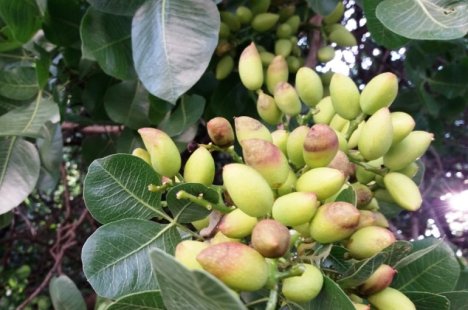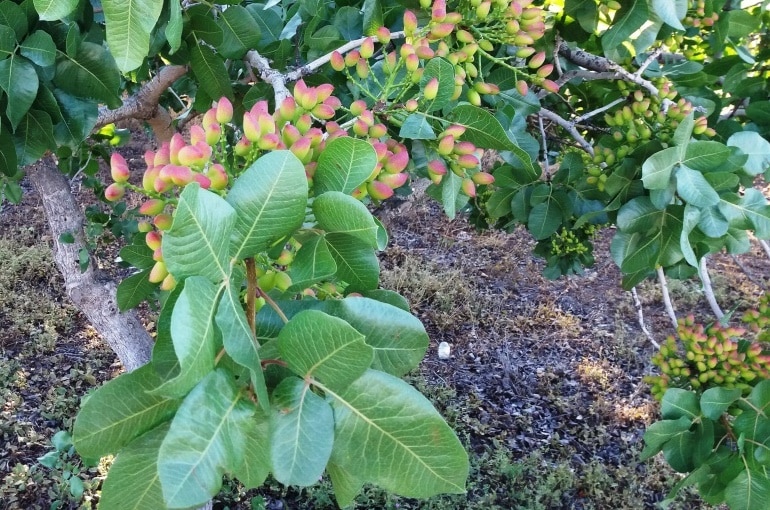
As we know, the highest level of pistachio cultivation is related to Kerman (Rafsanjan city). 2% of cultivated type (base) in the United States belongs to Kerman. The highest yield among pistachios types is related to Koleghoochi pistachio.
An overview of pistachio plant knowledge and its information
The popularity of Koleghoochi pistachio and the increase in the area under cultivation are related to the high production of this type.
The choice of base is the most important issue when constructing pistachio orchards. Cultivated rootstock and transplanted cultivar of Khorasan gardens belong to Koleghoochi type. There are about 90 known pistachio types in Iran, of which there are 30 kinds out of 90 known types in Khorasan.
The Kaleghoochi (Jumbo) is sensitive to spring cold due to its early flowering. Koleghoochi is sensitive to food shortages and their reduction. Among pistachio types, Ahmad Aghaei has the highest annual yield .
Pistachio tree should be watered every 12-12 days for 12 to 2 years. Fruit trees should be irrigated according to schedule and time. It is better to water the fruit trees once a month.
It is better to use organic fertilizers in a completely rotten and turbid form. The best depth of manure in pistachio trees is 30 to 40 cm. Delay in bud opening, sweeping, and micro leafing are related to zinc deficiency.

Symptoms of nutrient deficiency in pistachio
Significant symptoms of calcium deficiency are leaf spoon shape along the leaf and narrowing of the clusters. Sunburn and decreased fruit smile are related to potassium deficiency .
Potash makes the plant resistant to any water-drought stress and environmental stresses. The highest deficiency in pistachio trees is related to nitrogen. Yellowing of old and purple leaves at the margins of leaves and falling leaves and fruits are symptoms of nitrogen deficiency.
Most of the soils of Khorasan are calcareous texture with high pH. The pH of most orchards in Khorasan is between 8 and 9 due to calcareous soils and drought, which is a danger
Reddening of annual branches and leaf fall and drying are signs of salinity. Excessive use of one element reduces the absorption of other elements in the soil.
High magnesium in the soil prevents the absorption of iron, potash and calcium. One of the destructive effects of salinity is plant thirst and reduced movement of nutrients in the soil. Soil-soluble salts include chlorine, sodium, bicarbonate, sulfate, and magnesium.
Production of fertile clusters by pollination
Male flower buds open earlier than females. The flower buds of the female are sharp while the male buds are spherical. The number of male flower buds is more than females. Yellowing of the upper leaves of the tree are related to iron deficiency. Lack of copper in the soil causes the branches to become sticky and the skin to darken.پ
The use of barium in saline soils should be avoided. The element is one of the elements that is useful in increasing the life of pollen. Giving plenty of water and increasing the irrigation circuit will leach nutrients into the soil. Due to water shortage and long irrigation cycle, soil uptake conditions are not provided.
Potash plays an important role in plant resistance to salinity and pests. The number of male to female trees should be 1: 9. Symptoms of pollen deficiency (male) include osteoporosis and miscarriage. Pistachio trees have two bases and are pollinated by wind. The type of pruning in pistachio trees is jami and napiform.
Soil type and planting area of pistachio plant
The best soil for pistachio cultivation is loamy soils. Pistachio trees need a lot of fertilizer to produce a good crop. In general, pistachios need 600 grams of nitrogen per tree per year. Nitrogen, phosphorus and potash fertilizers are called basic fertilizers.
Nitrogen, phosphorus and potash fertilizers should be applied in autumn due to low soil movement. Phosphorus and potash fertilizers should be used near the roots due to low mobility. Symptoms of potassium deficiency can be eliminated by spraying 3 times. Zinc and calcium deficiency is more common in calcareous and alkaline soils. Zinc accelerates the growth of pollen tubes and increases inoculation and fruit formation.
The most sensitive time for pistachio water needs is July. Giving white fertilizer with water before ripening causes open mouted. 45% of pollination in pistachios is between 9 and 11 o'clock. In 82% of cases, the wind blows from the east at the time of pollination. At least one pollen grain must reach the female for fertility. The best distance to transfer male pollen to female is less than twenty meters. Females are receptive to male pollen for up to 3 days at hatching.
Male trees flower 7 days earlier than females. Choosing male and female cultivars that have the same flowering is one of the success factors. Climatic conditions, cultivar, base, soil texture and nutritional conditions are the most important factors of production.
Lack of air flow, rain and strong winds and storms prevent pollination. If not pollinated, the flowers will fall off or become hollow on the remaining tree. Pruning and feeding are the best way to control annuals. Annual pruning is necessary to adjust the amount of load to fit the plant.






User comments